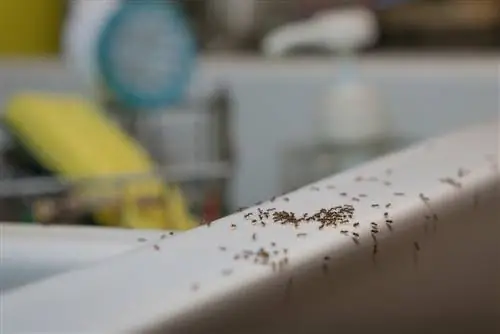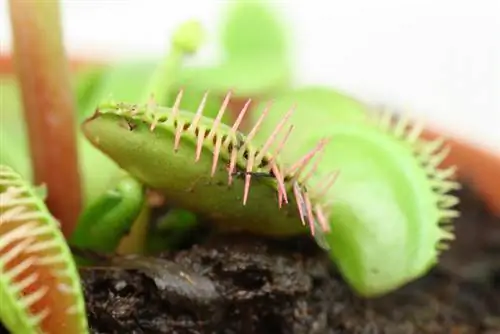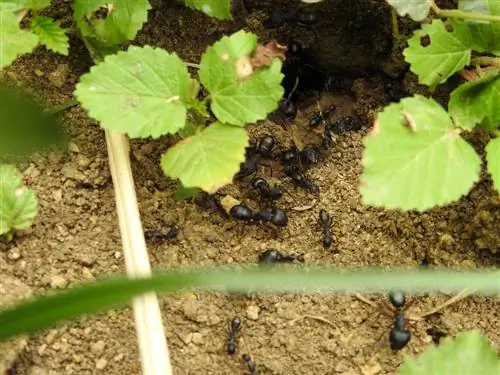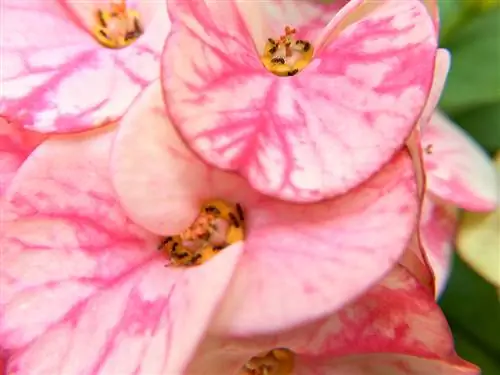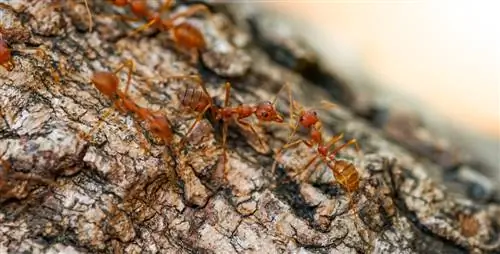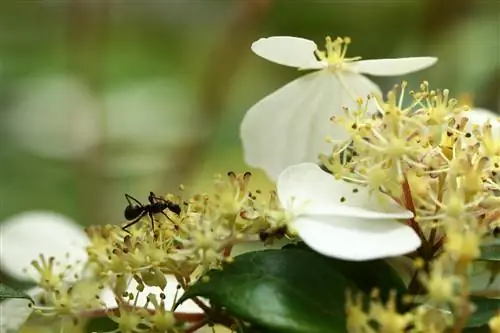- Author admin [email protected].
- Public 2023-12-16 16:46.
- Last modified 2025-01-23 11:22.
Ants are tiny, but they have a lot to offer. One scout ant can quickly lead to an entire colony and the ant trail quickly becomes overcrowded. However, chemical clubs should not be used immediately. They have many disadvantages and are often pointless.
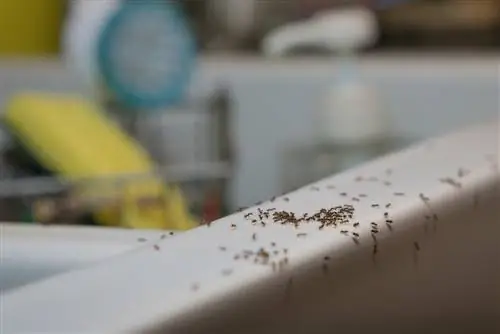
How do I get rid of ants in the kitchen?
To effectively control ants in the kitchen, identify the species, find its nest, and eliminate food sources. Then use natural or chemical baits to eliminate the ants and clean the affected areas with vinegar or tea tree oil to remove traces of scent.
What helps against ants in the kitchen?
Before taking control measures, you should identify the species. Stray ants can be carried outside with a glass. If an ant trail has formed, you should follow it to its origin and end. This way you can determine what the insects are attracted to and where their nest is.
Attract and eliminate
If the ants have settled in the wall or behind a cupboard, you should get rid of the nest. Use bait mixed with an attractant. You can then fight the ants by hand or use a feeding poison (€16.00 on Amazon). This should have a long latency period so that the ants transport the poison into the nest and feed their brood there. It is not easy to find suitable bait. Ants are very picky and do not eat everything, even though they are considered omnivores.
Suitable bait:
- Cherry plate: lay out overripe fruits and rinse ants regularly with water
- Protein source: Mix liver sausage or tuna with food poison
- Sugar: Set up a bowl with a solution of water and honey or sugar

Confuse and drive away
If the nest is outside so that the ant path leads to a food source, you should eliminate it first. You can then remove the ants’ scent traces. This is not easy because the markings can be in detours away from the recognizable ant trail. You should therefore clean the floor and walls thoroughly with water and a few splashes of vinegar or tea tree oil.
| Effect | Application | |
|---|---|---|
| Cinnamon | intense aroma confuses ants | sprinkle thickly on the ant trail |
| Lavender | Scent repels insects | place in front of entrance gates and column |
| Eucalyptus | essential oil deters animals | dripping into bowl |
Remove nest
After the ants have been controlled, it is important to remove the old nest. If the insects have nested in the partition walls, you should think about renovation. If the nest remains, colonization by immigrant ants will occur again within a short time.
Chemical Agents
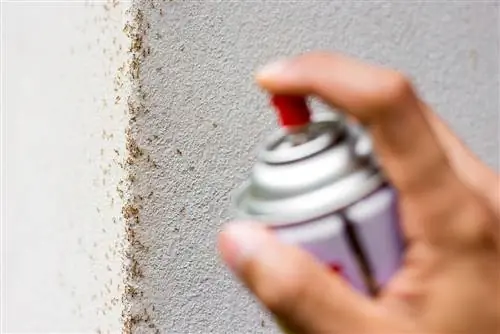
The use of chemical sprays should be avoided if possible
Ant poisons work against red, brown or black ants, regardless of the species. They contain various active ingredients that are used as contact or feeding poisons. However, there are ants that are not particularly impressed by poisons. In order to develop their full effect, the substances must be mixed with an attractive bait. Otherwise there is a risk that the ants will not eat the active ingredient.
The chemical club is the last resort. Poisons pollute the environment and endanger he alth.
| Type | Main active ingredient | Note | |
|---|---|---|---|
| Neudorff Loxiran S | Contactpoison | 1, 74 g/kg Chrysanthemum cinerariaefolium extract | Active ingredient decomposes under UV radiation |
| Neudorff Loxiran | feeding poison | 0, 15 g/kg Spinosad | Active ingredient too low concentration |
| COMPO ant bait | feeding poison | 0, 8 g/kg Spinosad | achieves good results |
| Celaflor Ant Spray | Contact poison, repellent | 1, 0 g/l Cypermethrin | can stay in the house for a long time even after cleaning |
| Fourmidor | feeding poison | 0.5 g/kg Fipronil | effective even in low concentrations |
| Detia Ant-EX | feeding poison | 5 g/kg permethrin | ineffective as a casting agent, should be mixed with bait |
When chemical agents don't work
It is often reported that the ant plague occurs again after a few days. This observation is not an indication that the drug had no effect. After a colony is wiped out, the next colony quickly follows. Ants send out scouts looking for new nesting opportunities and food sources. They follow the scent trails of the old people and settle in their nests when there is no competition.
Brown garden ant problem:
- most common ant in houses
- is unimpressed by commercially available feeding poisons
- escapes quickly when disturbed
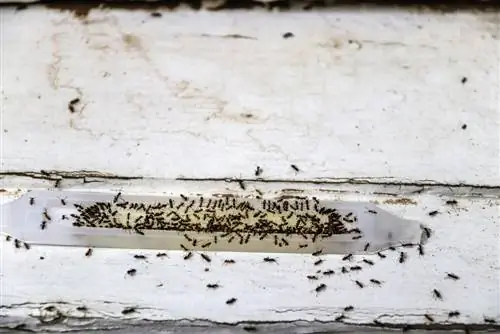
Poisonous baits with long-term effects are very effective in the fight against ants, but kill the entire colony
Fipronil
The biocide is an effective contact poison with a long latency period. It is mixed into bait as granules or administered as a casting agent. To ensure that children, pets and birds do not ingest the toxic substance, the products contain a bitter substance. After the ants eat the poison, symptoms do not appear immediately. They return to their nest and feed the food they have eaten to the queen and brood. After a few hours the poison causes death.
Disadvantages:
- possibly causes cancer
- is suspected of acting as a hormone-active substance
- can only be removed with turpentine and mechanical effort
Cypermethrin
The insecticide belongs to the pyrethroid group and acts as a contact poison when used as an infusion. The residues are effective for up to five months and also have an insect repellent effect. If the ants come into contact with the agent, they absorb it through the surface of their bodies. The active ingredient is distributed throughout the body and affects the nervous system. First, uncontrollable nerve impulses occur, making the ants appear excited and active. This is followed by cramps and coordination problems, until paralysis and complete inability to move occur.
Disadvantages:
- Insects can break down active ingredients if the concentration is too low
- cannot be removed by water
- disperses through house dust
Spinosad
The insecticide is obtained from the bacterium Saccharopolyspora spinosa and serves as a contact and feeding poison. After just a few hours, symptoms appear, which manifest themselves as signs of paralysis. The nervous system is massively damaged, so that the ants are completely unable to move. Spinosad is an effective poison, but it must be dosed sufficiently. If the dose is too low, it will not have the desired effect.
Disadvantages:
- dangerous for bees
- toxic to fish, aquatic organisms and algae
- causes long-term damage to water bodies
Permethrin
This insecticide from the pyrethroid group has a broad spectrum of action. It acts as a contact and feeding poison, which severely damages the ants' nervous system. The insects become immobile and die. The Federal Office for Risk Assessment advises against use in private households. Therefore, many manufacturers advise that the products should only be used professionally or by knowledgeable users.
Disadvantages:
- highly toxic for cats as they cannot break down the active ingredient due to a lack of enzymes
- toxic to bees and aquatic organisms
- contaminates untreated surfaces via house dust
Natural feeding poisons
Isolated ants do not have to be fought with a chemical agent straight away. There are natural substances that prove successful when used correctly. If there is an ant nest in the building, these remedies have no effect.
Tip
Before you fight the ants, you should identify them yourself or have them identified. The German Ant Protection Observatory is a first point of contact.
Excursus
Pharaoh ant
This species is not native to Europe, but was introduced from Asia. It is now spreading worldwide, although it does not survive the winter in freezing temperatures. The pharaoh ant is tied to warm environments, which is why it prefers to settle in well-tempered buildings. Since it is considered a vector of disease, timely control is necessary. The species is a major problem in hospitals because blood and pus are attractive to the insects.
Baking powder
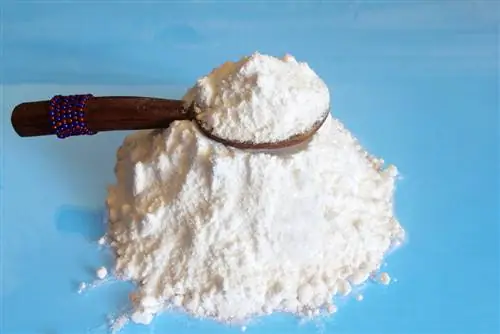
Baking soda only kills ants if it is sprinkled directly on them
The raising agent does not cause the often assumed effect of causing ants to burst. Rather, baking soda changes the pH value in the organism. Certain enzymes that are vital to ants can no longer survive. Eventually the ants die too. The prerequisite for a corresponding effect is that baking soda is used correctly. Every single ant needs to be heavily pollinated. Then tiny particles clog tracheas and settle on the antennae. The insects clean their antennae and ingest the powder.
Tips for use:
- Help with isolated ants in the house
- can temporarily reduce activity on ant trails
- not suitable for combating nests
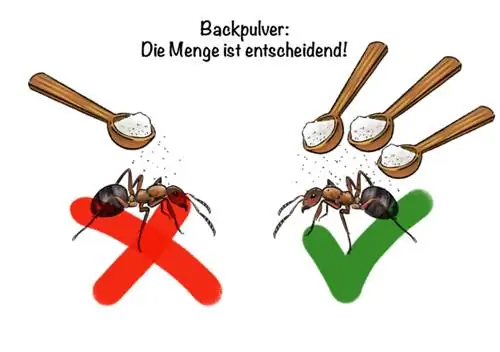
Insect Powder Plant
The species hides the Dalmatian insect flower from the genus Tanacetum, which has been used for centuries for its insecticidal effects. All parts of the plant contain pyretrins. These are very highly concentrated in the flower heads. The daisy family is used today to produce the insecticide pyrethrum. It affects the ants' nervous system because it damages the nerve pathways. The effect occurs immediately. The active ingredient breaks down more quickly when exposed to sunlight than artificially produced pyrethroids.
Notes:
- ground dried leaves and flowers
- Sprinkle powder directly onto ants
- repeat until all ants have been pollinated
- use carefully as it irritates eyes and mucous membranes
- toxic for children
Suddenly ants in the kitchen
There are various reasons why ants feel comfortable in human surroundings. They are not a sign of unhygienic conditions. Isolated ants usually don't pose a problem as they may just have gotten lost in the apartment. Many ants that have already formed an ant trail are more problematic.
Foraging
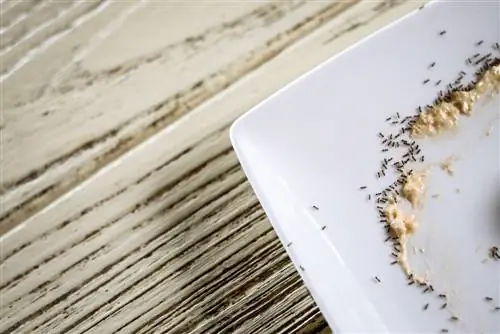
Sweet food sources magically attract ants
Ants are attracted by the smells of different foods. Sweet smells are particularly attractive. The insects not only eat overripe fruit but also the smallest crumbs that have accumulated in the kitchen behind the stove or under the seating area. Some ants are omnivores and will eat meat, cheese or bread. Pet feeding bowls or open organic waste also provide rich sources of food.
Introduced
Occasionally the insects are introduced unintentionally. This can be done using a flower pot that is taken from the balcony or terrace in winter and placed in the basement. More often, terrestrial ants have built a nest in the substrate and then spread throughout the home. In rare cases, certain species of ants find their way into the kitchen with food packaging. The pharaoh ant is one of the species that settles in warm rooms with good food availability. It can be introduced, for example, through bakery products.
Tip
Place the bucket in a water bath so that the ants are flushed out.
Nested
Modern building materials offer innovative nesting options that ants were previously unaware of. Thermal insulation appears to be particularly attractive if it is affected by splashing water or moisture. The material is reminiscent of the structure of dead wood and encourages ants to build nests. Old roof beams that have been damaged by moisture and insects are often an ideal nesting opportunity.
Immigrated
If the building is not suitable as a nesting site, you should examine the surrounding area a little more closely. A house in the middle of a natural garden also offers ants an optimal habitat. They nest in beds that line the building and can easily enter the apartment through open windows or door cracks.
Frequently asked questions
Where do ants in the kitchen come from?
If you spot ants in winter, they are usually hibernating species. They can nest in insulation materials on the partition walls or in roof beams, as they often find optimal nesting conditions here. Native species retreat into hibernation during the cold season and only awaken again in spring. Mild temperatures can disrupt this rhythm. A few ants find their way into the apartment from the adjacent bed or garden. They are attracted by different aromas and come through all the cracks.
What to do against ants in the kitchen?
First you should find out what species it is. Help is available from the German Ant Protection Observatory. After identifying the species, you need to find out if the ants have built a nest in the building. Trace ant trails to the beginning and end. Nests in the home should be combated and removed using appropriate means. Renovation is usually unavoidable. Ants looking for food can be prevented from doing their work by scents.
Which ants come into the kitchen?
The most common species found in homes is the brown garden ant. It can easily be confused with the two-colored garden ant. If you observe small ants that have a light, yellow body color, they may be the introduced pharaoh ant. In contrast to these mini ants, large species such as wood ants and carpenter ants tend to avoid proximity to humans. If these are flying ants, the likelihood of a nest in the walls is very likely. The insects are swarming because they are looking for a partner.
Is there a rent reduction if there are ants in the kitchen?
If you find ants in your apartment, you should inform your landlord. This must cover the costs for the one-off fight. If regular measures are necessary, the landlord can pass on the costs incurred to the tenant as additional costs. A reduction in rent is only permitted if the ant fall no longer allows normal living.

